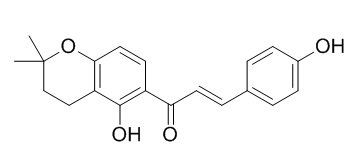Dorsmanin A
Dorsmanin A is a natural product from Psoralea corylifolia.
Inquire / Order:
manager@chemfaces.com
Technical Inquiries:
service@chemfaces.com
Tel:
+86-27-84237783
Fax:
+86-27-84254680
Address:
1 Building, No. 83, CheCheng Rd., Wuhan Economic and Technological Development Zone, Wuhan, Hubei 430056, PRC
Providing storage is as stated on the product vial and the vial is kept tightly sealed, the product can be stored for up to
24 months(2-8C).
Wherever possible, you should prepare and use solutions on the same day. However, if you need to make up stock solutions in advance, we recommend that you store the solution as aliquots in tightly sealed vials at -20C. Generally, these will be useable for up to two weeks. Before use, and prior to opening the vial we recommend that you allow your product to equilibrate to room temperature for at least 1 hour.
Need more advice on solubility, usage and handling? Please email to: service@chemfaces.com
The packaging of the product may have turned upside down during transportation, resulting in the natural compounds adhering to the neck or cap of the vial. take the vial out of its packaging and gently shake to let the compounds fall to the bottom of the vial. for liquid products, centrifuge at 200-500 RPM to gather the liquid at the bottom of the vial. try to avoid loss or contamination during handling.
Exp Parasitol.2015, 153:160-4
Industrial Crops and Products2023, 199:116746.
Antioxidants (Basel).2023, 12(5):1111.
J Herbmed Pharmacol.2018, 7(4):280-286
J of Dentistry & Oral Health2019, 2641-1962
Agriculture2022, 12(2),227.
J Appl Biol Chem.2022, 65(4):pp.463-469.
Nanjing University of Chinese Medicine2022, 345930.
J Clin Med.2019, 8(10):E1664
Front Nutr.2024, 11:1507886
Related and Featured Products
BMC Complement Altern Med. 2012 Jun 29;12:83.
Antimicrobial activities of the methanol extract and compounds from the twigs of Dorstenia mannii (Moraceae).[Pubmed:
22747736 ]
Dorstenia mannii (Moraceae) is a medicinal herb used traditionally for the treatment of many diseases. In the present study, the methanol extract of D. mannii and nine of its isolated compounds, namely Dorsmanin A (1), B (2), C (3), D (4), E (6), F (7), G (8) dorsmanin I (9) and 6,8-diprenyleriodictyol (5), were tested for their antimicrobial activities against yeast, Mycobacteria and Gram-negative bacteria.
METHODS AND RESULTS:
The microplate alamar blue assay (MABA) and the broth microdilution method were used to determine the minimal inhibitory concentration (MIC) and minimal microbicidal concentration (MMC) of the above extract and compounds on a panel of bacterial species. The results of the MIC determinations demonstrated that the methanol extract as well as compounds 3 and 8 were able to prevent the growth of all the fourteen studied microorganisms within the concentration range of 4 to 1024 μg/ml. The lowest MIC value for the methanol extract (64 μg/ml) was obtained on Candida albicans. The lowest value for individual compounds (4 μg/ml) was recorded with compounds 3 on Pseudomonas aeruginosa PA01 and 7 on Eschericia coli ATCC strain. The MIC values recorded with compounds 3 on P. aeruginosa PA01, 6 on C. albicans,7 on P. aeruginosa PA01 and K. pneumoniae ATCC strain and C. albicans,and 8 on P. aeruginosa PA01, PA124, P. stuartii, M. tuberculosis MTCS1 were lower than or equal to those of the reference drugs. MMC values not greater than 1024 μg/ml were recorded on all studied microorganisms with compounds 3 and 8.
CONCLUSIONS:
The overall results of the present investigation provided evidence that the crude extract of D. mannii as well as some of its compounds such compounds 3 and 8 could be a potential source of natural antimicrobial products.
Phytochemistry. 2002 Apr;59(8):877-83.
Chalcones and other constituents of Dorstenia prorepens and Dorstenia zenkeri.[Pubmed:
11937170]
METHODS AND RESULTS:
The twigs of Dorstenia prorepens furnished the digeranylated chalcone, 5,3'-(3,7-dimethyl-2,6-octadienyl)-3,4, 2',4'-tetrahydroxychalcone while Dorstenia zenkeri yielded the 3',4'-(3-hydroxy-2,2-dimethyldihydropyrano)-4,2'-dihydroxychalcone and a bichalcone. 4-Hydroxylonchocarpin was found in both plants. D. prorepens also yielded the known compounds: psoralen, bergapten, beta-sitosterol and its D-glucopyranosyl derivative. D. zenkeri yielded p-hydroxybenzaldehyde, Dorsmanin A, 4,2',4'-trihydroxychalcone and 4,2',4'-trihydroxy-3'-prenylchalcone.
CONCLUSIONS:
Structures of the new compounds were established by UV, IR, MS and 2-D NMR analysis.



